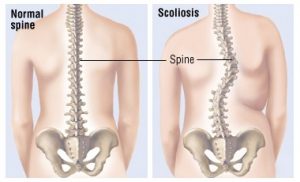As regular clients and readers will be aware, in 2017 we opened our sister clinic, the UK Scoliosis Clinic to provide a specialist service for individuals suffering from a common, but often overlooked condition – scoliosis. Like most conditions, scoliosis can be treated most easily when it is identified early, and with this in mind June 2019 will be scoliosis awareness month. We’ll be posting information about scoliosis in the run up to, and during, scoliosis awareness month and will also be hosting some special events. This week lets quickly recap what scoliosis is, and why you should pay attention this coming June.
What is scoliosis?
Scoliosis is a condition that causes a 3-dimensional shift in the position of the spine, away from its normal position. Scoliosis affects both adults and children, although most people associate the condition most strongly with the young. Approximately 3-4% of children are affected by scoliosis – that’s about one per class at school. In adults, 30-40% of individuals over 50 have some degree of scoliosis, meaning the condition is actually more common in older individuals – although it tends to be more severe in children and young adults.
The earlier scoliosis is detected, the better the treatment and management plan will be. Early detection of scoliosis helps reduce the risk of progression and creates the opportunity for scoliosis to be treated with non-surgical, conservative methods – left untreated however, many scoliosis patients eventually need surgery.
Less frequently, scoliosis can at times be a sign of congenital spinal malformations, underlying neurological / neuromuscular conditions, metabolic conditions, traumas or significant pathologies.
Research suggests that you are at a higher risk of scoliosis if you have a family history of the condition. In addition, significantly higher than average rates of scoliosis have been observed amongst participants in certain activities – ballet dancers, gymnasts and dancers are thought to be as much as 12 times more likely to develop scoliosis[i] than the general population.
What causes Scoliosis?
In young people, the exact cause of the majority of scoliosis cases is currently unknown. 80% of scoliosis cases in children and young people are “Idiopathic”.” Idiopathic” literally means “without known cause”. Scientists currently believe there may be a genetic factor, since scoliosis appears to run in families – but more research is needed before we can say for certain.
In some cases (about 20%) a malformation of the spinal bones or another underling condition might be the cause of scoliosis.
Idiopathic scoliosis is typically classified according to the age that it is diagnosed. It is most common in adolescents (over 10 years), but also occurs in infants (under 3 years) and juvenile’s (3-10 years).
The number of people affected by scoliosis increases significantly after the age of 50 and in this case the cause is generally known. In adults, the cause of scoliosis is almost always either childhood scoliosis which has not been treated, or a direct result of increased spinal degeneration and ligament weakening. This kind of age-related scoliosis is known as Degenerative or “De-Novo” scoliosis.
Do I have scoliosis?
Scoliosis can be difficult to detect in the absence of proper screening, which is one of the major reasons we founded a specialist clinic. We provide a free screening service here at the clinic, so if you have concerns just drop in!
In the very early stages the signs may be very hard to notice by anyone other than a trained professional – As such, scoliosis is frequently first suspected once it has developed to the point where someone notices something slightly off in terms of your visual appearance – for example, your clothes might fit awkwardly or hang unevenly.
In many cases, scoliosis is first noticed while in bathing suit or changing. For instance, a parent could first notice a hump in an adolescent’s back while bending forward or a sideways curvature while at the pool or beach.
Some general signs of scoliosis include:
- From the back, the spine may have a C or S shape curve rather than that of a straight line, this can make the waist lines uneven or one shoulder lower than the other.
- From the side view, the normal spinal curves are often straightened, which makes the mid-back appear flat. Shoulder blades may be prominent.
- While looking from the head down to the feet, there is a rotation or twist which can cause ribs or one side of the lower back to appear humped or more prominent.
Scoliosis symptoms are not all visual however – in our day to day work at complete chiropractic, we meet many patients who are suffering with some degree of scoliosis, either as a primary or secondary complaint. Common complaints which can be (but which are not necessarily) linked to scoliosis include:
- Changes with walking. When the spine abnormally twists and bends during walking, it can cause the hips to be out of alignment which changes a person’s gait or how they walk. You might also notice you get tired quickly when walking.
- Reduced range of motion. You might notice a reduced flexibility.
- Trouble breathing. If the spine rotates enough and diverges from its normal position enough, the rib cage can twist and tighten the space available for the lungs.
- Cardiovascular problems. Similarly, if the rib cage twists enough, reduced spacing for the heart can hamper its ability to pump blood.
- Many scoliosis patients report back pain ranging from moderate to severe. More research is required to determine if scoliosis is the main cause of the pain, but pain is nonetheless often the symptom which causes people to seek treatment
Next week, we’ll take a look at how scoliosis can be treated, and what the prognosis is for scoliosis sufferers.
‘Prevalence and predictors of adolescent idiopathic scoliosis in adolescent ballet dancers’
Longworth B., Fary R., Hopper D, Arch Phys Med Rehabil. 2014 Sep;95(9):1725-30. doi: 10.1016/j.apmr.2014.02.027. Epub 2014 Mar 21.


